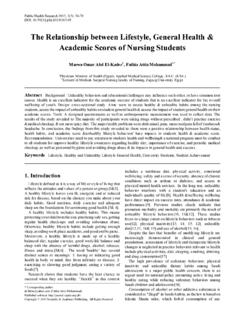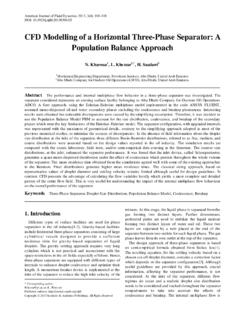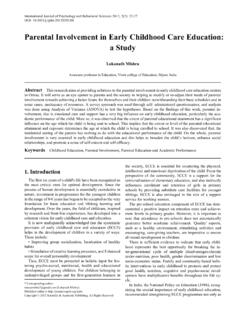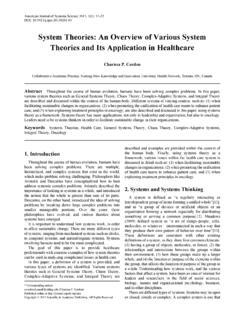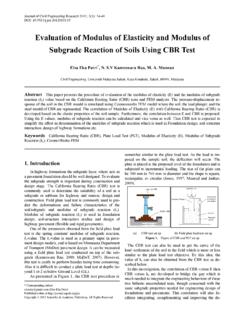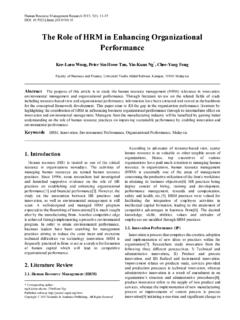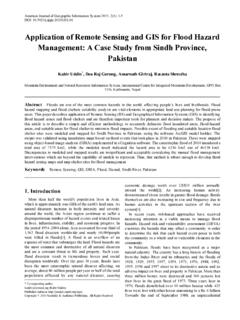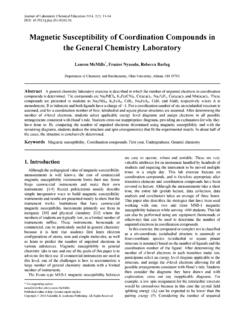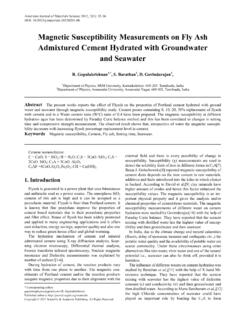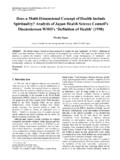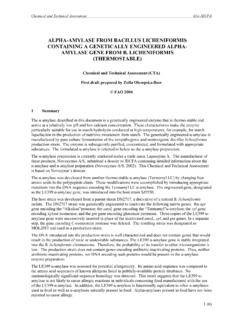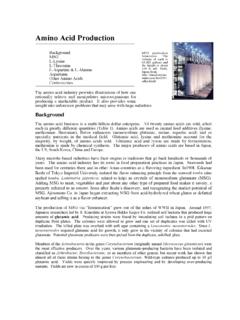Transcription of Production of Protease and Amylase from Bacillus subtilis
1 Advances in Life Sciences 2011; 1(2): 49-53 DOI: Production of Protease and Amylase from Bacillus subtilis and Aspergillus niger Using Parkia biglobossa (Africa Locust Beans) as Substrate in Solid State Fermentation Oyeleke S. B.*, Oyewole O. A. , Egwim, E. C. Department of Biochemistry, Federal University of Technology, Pmb 65, Minna, Niger State, Nigeria Abstract Bacillus subtilis and Aspergillus niger were utilized for the Production of Amylase and Protease enzymes in this study. Parkia biglobossa (Africa Locust Beans) shell was used as substrate by both organisms for the Production of Amylase and Protease enzyme. The optimum temperature for the activity of Amylase and Protease enzymes produced by Bacillus subtilis was 50oC, while 30oC and 40oC was recorded for Amylase and Protease enzyme produced by Aspergillus niger with an activity of mg/ml/sec, mg/ml/sec for Amylase and Protease enzyme by Bacillus subtilis and mg/ml/sec, mg/ml/sec for Amylase and Protease produced by Aspergillus niger respectively.
2 Optimum pH was attained at pH 9 for Amylase and Protease enzyme produced by Bacillus subtilis with an activity of mg/ml/sec and mg/ml/sec respec-tively. The optimum pH for the activity of Aspergillus niger was recorded at pH 5 and pH 6 for Amylase and Protease with an activity of mg/ml/sec and respectively. The result showed that both organisms utilized Parkia biglobossa to produce extracellular Amylase and Protease , but the activity of Amylase enzyme produced by both organisms was greater than the activity of Protease enzyme and enzymes produced by Bacillus subtilis showed superior activity which can be useful industrially. Keywords Bacillus subtilis , Aspergillus niger, Amylase , Protease Enzymes, Parkia biglobossa 1. Introduction Enzymes are substances present in the cells of living or-ganisms in minute amounts and are capable of speeding up chemical reactions (associated with life processes), without themselves being altered after the reaction.
3 They accelerate the velocity of the reaction without necessarily initiating it (Oyeleke and Oduwole, 2009). Microbial enzymes are preferred to those from both plant and animal sources because they are cheaper to produce, and their enzyme contents are more predictable, controllable and reliable (Burhan et al., 2003). These naturally occurring enzymes are quite often not readily available in sufficient quantities for food applications or industrial use. However, by isolating microbial strains that produce the desired en-zyme and optimizing the conditions for growth, commercial quantities can be obtained. This technique, well known for more than 3,000 years, is called fermentation. Some of the typical applications include enzyme use in the Production of sweeteners, chocolate syrups, bakery products, alcoholic beverages, precooked cereals, infant foods, fish meal, cheese * Corresponding author: (Oyeleke S.)
4 B.) Published online at Copyright 2011 Scientific & Academic Publishing. All Rights Reserved and dairy products, egg products, fruit juice, soft drinks, vegetable oil and puree, candy, spice and flavour extracts, and liquid coffee, as well as for dough conditioning, chill proofing of beer, flavour development, and meat tenderizing. Enzymes also play a significant role in non-food applications. Industrial enzymes are used in laundry and dishwashing detergents, stonewashing jeans, pulp and paper manufacture, leather dehairing and tanning, de-sizing of textiles, deinking of paper, and degreasing of hides (Enzyme Technical Asso-ciation, 2001). The West African locust bean (dawadawa) belongs to the family leguminosa. The English common name is baobab, probably derived from the Arabic bu hibab, which means fruit with several seeds (Kurebgaseka, 2005).
5 Readily available agricultural waste such as the shell of Parkia biglobossa which presently constitutes part of the menace to solid waste management may be used as substrate for growth by microorganism in solid state fermentation. Agro-industrial residues are generally considered the best substrates for the solid state fermentation processes, and use of solid state fermentation for the Production of enzymes is no exception to that. A number of such substrates have been employed for the cultivation of microorganisms to produce host of enzymes. Some of the substrates that have been used included sugar cane bagasse, wheat bran, rice bran, maize bran, gram bran, wheat straw, rice straw, rice husk, soyhull, 50 Oyeleke S. B. et al.: Production of Protease and Amylase from Bacillus subtilis and Aspergillus niger using Parkia biglobossa (Africa Locust Beans) as Substrate in Solid State Fermentation sago hampas, grapevine trimmings dust, saw dust, corncobs, coconut coir pith, banana waste, tea waste, cassava waste, palm oil mill waste, aspen pulp, sugar beet pulp, sweet sor-ghum pulp, apple pomace, peanut meal, rapeseed cake, co-conut oil cake, mustard oil cake, cassava flour, wheat flour, corn flour, steamed rice, steam pre-treated willow, starch, etc (Mitra et al.)
6 , 1994). The aim of this research work is to produce enzymes from Aspergillus niger and Bacillus subtilis using Parkia biglo-bossa (African locust beans) shell powder as substrate in solid state fermentation. 2. Material and Method Sample Collection Dried fruits of Parkia biglobossa were collected from the crown of standing tree by using a hook to cut the hanging fruits. The tree was located behind the lecture theatre at the Federal University of Technology Minna, Nigeria. The seeds were then removed from the shell and discarded. The shell was further dried in the sun for some days. After drying, it was pounded using a portable mortal. It was then sieved and the filtrate was collected and stored for further use. Five gram of soil sample was collected at the front of the Microbiology laboratory of the Federal University of Technology Minna.
7 It was then taken to the laboratory for microbial analysis. Media Preparation The nutrient agar, Sabouraud Dextrose agar and Starch agar medium used for this work were prepared according to the manufacturer s instructions. Screening for Amylolytic Activity of A. niger The amylolitic activity of A. niger was determined using the starch agar plate method as described by Bertrand et al. (2004). This was done by inoculating the identified organism into Sabourad Dextrose Agar medium which was supple-mented with 1g of starch. The agar plates were then incu-bated at 30 C for 5 days. After the incubation period, Lugol s iodine solution was added to the culture plate to identify the zones around the cultures. The diameter formed after the addition of iodine solution was measured to represent the amylolytic activity.
8 Screening for Amylolytic Activity of B. subtilis The amylolitic activity of the test isolates was determined by using the starch agar plate method, by inoculating the identified Bacillus species into Nutrient Agar medium which was supplemented with 1g of starch. The agar plates were then incubated at 37 C for 24hrs. After the incubation period, Lugol s iodine solution was added to the culture plate to identify the zones around the cultures. The diameter formed after the addition of iodine solution was measured to repre-sent the amylolytic activity. Preparation of Medium Used for Amylase Production by B. subtilis The medium was prepared by weighing the following medium composition in grams per litre; Bacteriological peptone-6g, , , The above medium composition were dissolved in 1000ml of distilled water after which 100ml of the medium was meas-ured into a conical flask (250ml capacity each) heated on hot plate to homogenize and then sterilized in an autoclave at 121 C for 15 minutes after which they were removed and allowed to cool before the organism was inoculated.
9 Preparation of the Medium Used for Amylase Product- ion by A. niger The medium was prepared by weighing the following medium composition in grams per litre; , NH4NO3-10g, , , , Substrate-20g. The above medium composition were dissolved in 1000ml of distilled water after which 100ml of the medium was measured into conical flask (250ml capacity each) heated on hot plate to homoge-nize and then sterilized in an autoclave at 121 C for 15 min-utes after which they were removed and allowed to cool before the organism was inoculated. Preparation of Medium used for Protease Production by B. subtilis The media used for optimized Production of Protease en-zyme consisted of substrate 1% (w/v), casein , yeast extract , KH2PO4 , Na2CO3 1%, , substrate and pH The above medium composition were dissolved in 1000ml of distilled water after which 100ml of the medium was measured into a conical flask (250ml capacity each) heated on hot plate to homogenize and then sterilized in an autoclave at 121 C for 15 minutes after which they were removed and allowed to cool before in-oculating.
10 Preparation of Medium used for Protease Production by A. niger The medium was prepared by weighing the following composition in grams per litre (g /L): peptone, 5; yeast ex-tract 3; malt extract 2, substrate 2 and pH 8. The above me-dium composition were dissolved in 1000ml of distilled water after which 100ml of the medium was measured into a conical flask (250ml capacity each) heated on hot plate to homogenize and then sterilized in an autoclave at 121 C for 15 minutes after which they were removed and allowed to cool before inoculating. Extraction of Amylase and Protease Enzyme from B. subtilis After incubation, the Production medium was centrifuged at 6000rpm for 30 min to separate the cells. The supernatant was collected as it contained the crude enzyme and stored at 4oC till further use.
